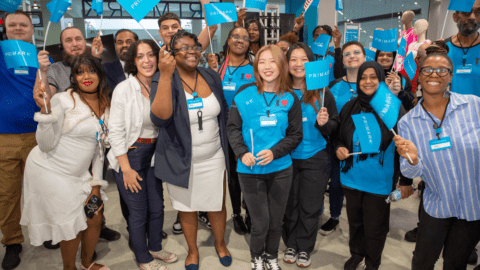The cross-pollination between corporations and non-profit organizations has produced a family of businesses referred to as benefit corporations — defined as for-profit entities that make humanitarian and environmental concerns a core focus of their decision-making processes.
Because of their focus on public service, benefit corporations garner strong followings from consumers based on good will. They also are ideally situated to be agents and long-term funders of social good.
The enterprises that fall in this category have established committed relationships to charitable causes that go beyond donating to non-profit organizations (NPOs). TOMS, the footwear retailer, gained mainstream popularity and worldwide exposure for the “One for One” program, which is core to the entire TOMS business. With this initiative, TOMS matches every pair of shoes sold by donating another pair to a child in need.
Advertisement
Warby Parker, the multichannel prescription eyeglasses and sunglasses retailer, has a similar program called “Buy a Pair, Give a Pair.” For every pair of glasses sold, a matching pair is donated to a person who does not have access to affordable eye care.
Due to the success of these initiatives, charitable campaigns and social good business models are becoming a key component of successful retail businesses. As a result, entrepreneurs and retailers are integrating social good into their brand identities and overall business strategies.
Following are four tips for creating successful social good retail programs:
Be Transparent
Consumers contributing to charitable causes want to know their money is going to directly benefit the cause, not the pockets of the executives running the charity. Additionally, some causes are not commonly known by most consumers, therefore an educational component is necessary.
Geek Supply is an online vendor of home and office accessories. Two of the company founders suffer from sickle-cell anemia (SCA), a hereditary blood disorder that primarily affects individuals of Sub-Saharan African and Indian descent. Jimi Olaghere, Co-Founder of Geek Supply, has had two surgeries, a heart attack and multiple bouts of pneumonia as a result of SCA.
“With SCA, you can’t really see any symptoms on the outside,” said Olaghere, “No one call tell how much pain I’m in.”
Because SCA is so hidden from the public eye, awareness and transparency are the chief goals for the Geek Supply team, Olaghere noted. Geek Supply focuses on showing customers how profits are used to benefit SCA charities through pictures, videos and blog posts. Geek Supply built its business model on the examples of various retailers like Warby Parker and Nasty Gal, but the importance of financial transparency was directly influenced by TOMS, according to Olaghere.
“We help the NPOs promote anything they’re doing in regards to SCA on the Internet,” Olaghere said. “It’s about getting more eyeballs on blood drives or any other events they plan.”
Approximately 10% of all monthly sales are donated to the various SCA organizations that Geek Supply has partnered with, such as the Sickle Cell Association of New Jersey. Each organization receives money based on a rotating schedule.
Do More Than Make Donations
Some companies, such as Love41, take a more direct approach to their charitable efforts. Headed by husband-and-wife-team Dave Munson and Suzette Munson, Love41 sells accessories and clothing that are handmade by locals from war-torn or impoverished nations. To achieve the goals of the program, Love41 partners with organizations including Raven & Lily. (Dave Munson also is the president of Saddleback Leather, a manufacturer of high-end leather products. Suzette designs the Love41 product line, while Dave and Saddleback Leather provide the production, personnel and funds.)
The Munsons make sure that all the products in the Love41 catalogue have a strong tie with its causes and charities. For example, one of the Love41 products is made from spent bullet casings. Many Ethiopian women who are diagnosed as HIV positive often are disowned by their families and left to die, Dave Munson explained. Raven & Lily teaches the women a craft in order to help them earn a living. The group also provides educational services to their children.
When producing products for charitable causes, retailers must adhere to the same product quality standards dedicated to the for-profit side of the business, according to Dave Munson. He noted that some retailers are “complacent” when developing products for social good initiatives, assuming that product quality should not be a priority if consumers are buying them out of good will. Benefit companies that release subpar offerings will quickly become irrelevant to consumers, he said. Consumers will have no interest in revisiting a benefit retailer’s web site if the products are mediocre. Moreover, a benefit retailer offering excellent products can get sales from an extended audience that may not initially be interested in the charity, he explained.
“It bothers me when a company says ‘buy from us because we support breast cancer research,’ or ‘buy from us because we support literacy,’” Munson said. “People need to buy from you because you have a great product, not because you do nice things. We’re operating from the fact that we need to design really great stuff. Let the stories be told and have people coming back for more.”
The Munsons are committed to never taking any money for personal use from Love41 revenue. Some of the earnings are used to cover overhead and aid in expansion. However, most revenue is given to local workers who create the products. In the future, Love41 plans to open manufacturing centers in Rwanda and Uganda.
Learn From NPOs
Working together with NPOs for charitable causes is not always easy. Retailers should be aware of the challenges and hurdles when entering into these partnerships.
For example, Patagonia partnered with The Nature Conservancy and Ovis XXI to create a sustainable wool industry in Patagonia, Argentina, with the goal of combating the desertification of the grasslands in the eponymous city where Patagonia got its name.
“We took a trip to Patagonia to meet with The Nature Conservancy and Ovis XXI to see what the situation was in the area,” said Todd Copeland, Environmental Product Specialist at Patagonia. The companies soon learned that the grasslands were eroding from the unsustainable native wool industry.
The partnership was faced with a variety to problems. The degradation of the land had to be reversed but the ranchers also needed their sheep to graze. Different regions of the area had separate requirements for healthy grass, so scientists needed to be brought in.
Today, the grasslands are green and Patagonia runs a successful wool industry with the native ranchers. In the fall, Patagonia will sell 50 different products created with wool from the grasslands.
Through the course of the initiative, each member of the partnership has garnered valuable insights from one another regarding how to further their unique causes. “The first step in establishing relationships with NPOs is donating money, which is great,” Copeland said, “but the more you get involved with these groups, the more integrated it gets. NPOs learn how to promote themselves by being involved with businesses, and businesses learn how to generate good will from NPOs. It’s an interesting relationship for both parties.”
Be Personally Invested
To develop a successful business model around social good and charitable causes, retailers must have a genuine, personal interest in the causes they promote, according to industry experts.
For example, Olaghere explained that he started Geek Supply because he had “suffered in silence” from sickle cell anemia during his lifetime, and didn’t want that to be the case for others diagnosed with the disease.
Benefit and social good retailers can display commitment by visiting the places and people they want to help. Doing so will create a personal investment in the humanitarian vision. Retailers who visit the charities they support will be ones whose “hearts will be in it,” according to Munson.
“You have to go and visit these places,” Munson said. “If you go to Thailand and see child prostitution for yourself — kids in chains and young girls being raped every day — you’re going to be passionate about fighting these things.” Giving money is great, but Munson stressed that “being involved” is even better.
Copeland shared a story about Yvon Chouinard, President of Patagonia, who believes that doing the right thing for society is doing the right thing for business.
Chouinard’s first business was making climbing equipment. Traditionally, all mountain climbing was done through the use of hammers and pitons.
However, Chouinard noticed that these tools heavily damaged the mountains that the climbers came to enjoy. In response, he developed a variety of new environmentally friendly products, such as rappel nuts that don’t need to be nailed and chalk that was developed to improve handgrip. The new products were released in the 1972 Chouinard catalogue, with a treatise on environmental conservation and a foreword by Chouinard and Tom Frost, during a time when the concern for mountain preservation was practically nonexistent.
The gamble paid off, and today Chouinard is referred to as “the father of clean climbing.”
By having a personal stake in a charity, retailers can further the causes they promote while also positioning themselves as leaders in their respective verticals. In the changing digital landscape, the connectivity of social media has made it easier than ever for retailers and non-profit organizations to galvanize communities into action through quality products.








